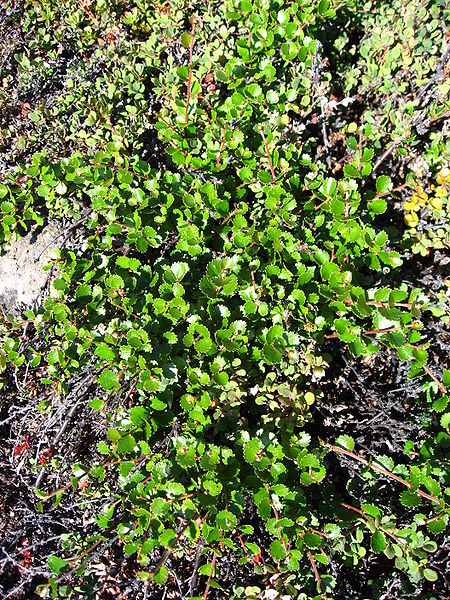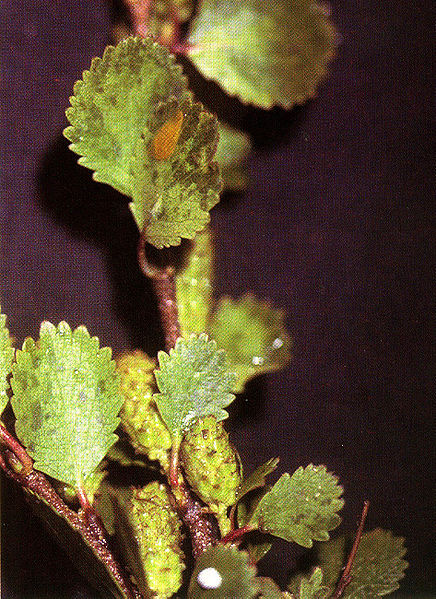 |
|
http://commons.wikimedia.org/wiki/User:Slaunger |
 |
| http://commons.wikimedia.org/wiki/User:MPF |
Translate this page:
Summary
Physical Characteristics

 Betula_nana is a deciduous Shrub growing to 0.3 m (1ft) by 0.5 m (1ft 8in).
Betula_nana is a deciduous Shrub growing to 0.3 m (1ft) by 0.5 m (1ft 8in).
See above for USDA hardiness. It is hardy to UK zone 2 and is not frost tender. It is in flower in May, and the seeds ripen in July. The species is monoecious (individual flowers are either male or female, but both sexes can be found on the same plant) and is pollinated by Wind.
Suitable for: light (sandy), medium (loamy) and heavy (clay) soils, prefers well-drained soil and can grow in heavy clay and nutritionally poor soils. Suitable pH: mildly acid, neutral and basic (mildly alkaline) soils. It can grow in semi-shade (light woodland) or no shade. It prefers moist soil. The plant can tolerates strong winds but not maritime exposure.
UK Hardiness Map
US Hardiness Map
Synonyms
Plant Habitats
Edible Uses
Young leaves and catkins - raw[172]. The buds and twigs are used as a flavouring in stews[172].
References More on Edible Uses
Medicinal Uses
Plants For A Future can not take any responsibility for any adverse effects from the use of plants. Always seek advice from a professional before using a plant medicinally.
The bark is antirheumatic, astringent, lithontripic, salve and sedative[172]. Moxa is prepared from the plant and is regarded as an effective remedy in all painful diseases[4]. No more details are given, but it is likely that the moxa is prepared from yellow fungous excretions of the wood, since the same report gives this description when talking about other members of the genus[K]. A compound decoction of the leaves has been used in the treatment of stomach ache and intestinal discomfort[257].
References More on Medicinal Uses
The Bookshop: Edible Plant Books
Our Latest books on Perennial Plants For Food Forests and Permaculture Gardens in paperback or digital formats.

Edible Tropical Plants
Food Forest Plants for Hotter Conditions: 250+ Plants For Tropical Food Forests & Permaculture Gardens.
More

Edible Temperate Plants
Plants for Your Food Forest: 500 Plants for Temperate Food Forests & Permaculture Gardens.
More

More Books
PFAF have eight books available in paperback and digital formats. Browse the shop for more information.
Shop Now
Other Uses
Plants can be used for ground cover, forming a spreading hummock up to 1.2 metres across[208]. An infusion of the plant is used as a hair conditioner and dandruff treatment[172]. A yellow dye is obtained from the leaves[4]. The plant has been used as a tinder, even when wet, and for cooking fires when there is a lack of larger wood[257]. It is likely that the bark was used for tinder[K].
Special Uses
References More on Other Uses
Cultivation details
Succeeds in a well-drained loamy soil in a sheltered position[11, 200]. Grows well in heavy clay soils. Grows well in moist places or the heath garden[182]. Shade tolerant[200]. This species is native to areas with very cold winters and often does not do well in milder zones. It can be excited into premature growth in mild winters and this new growth is susceptible to frost damage[200]. Hybridizes freely with other members of this genus[50]. Trees are notably susceptible to honey fungus[200].
References Carbon Farming Information and Carbon Sequestration Information
Temperature Converter
Type a value in the Celsius field to convert the value to Fahrenheit:
Fahrenheit:
The PFAF Bookshop
Plants For A Future have a number of books available in paperback and digital form. Book titles include Edible Plants, Edible Perennials, Edible Trees,Edible Shrubs, Woodland Gardening, and Temperate Food Forest Plants. Our new book is Food Forest Plants For Hotter Conditions (Tropical and Sub-Tropical).
Shop Now
Plant Propagation
Seed - best sown as soon as it is ripe in a light position in a cold frame[78, 80, 113, 134]. Only just cover the seed and place the pot in a sunny position[78, 80, 134]. Spring sown seed should be surface sown in a sunny position in a cold frame[113, 134]. If the germination is poor, raising the temperature by covering the seed with glass can help[134]. When they are large enough to handle, prick the seedlings out into individual pots and grow them on in a cold frame for at least their first winter. Plant them out into their permanent positions in late spring or early summer, after the last expected frosts. If you have sufficient seed, it can be sown in an outdoor seedbed, either as soon as it is ripe or in the early spring - do not cover the spring sown seed. Grow the plants on in the seedbed for 2 years before planting them out into their permanent positions in the winter[78, 80, 113, 134].
Other Names
If available other names are mentioned here
Native Plant Search
Search over 900 plants ideal for food forests and permaculture gardens. Filter to search native plants to your area. The plants selected are the plants in our book 'Plants For Your Food Forest: 500 Plants for Temperate Food Forests and Permaculture Gardens, as well as plants chosen for our forthcoming related books for Tropical/Hot Wet Climates and Mediterranean/Hot Dry Climates. Native Plant Search
Found In
Countries where the plant has been found are listed here if the information is available
Weed Potential
Right plant wrong place. We are currently updating this section.
Please note that a plant may be invasive in one area but may not in your area so it’s worth checking.
Conservation Status
IUCN Red List of Threatened Plants Status :

Growth: S = slow M = medium F = fast. Soil: L = light (sandy) M = medium H = heavy (clay). pH: A = acid N = neutral B = basic (alkaline). Shade: F = full shade S = semi-shade N = no shade. Moisture: D = dry M = Moist We = wet Wa = water.

Expert comment
Author
L.
Botanical References
1117200
Links / References
For a list of references used on this page please go here
Readers comment
| Add a comment |
|
If you have important information about this plant that may help other users please add a comment or link below. Only comments or links that are felt to be directly relevant to a plant will be included. If you think a comment/link or information contained on this page is inaccurate or misleading we would welcome your feedback at [email protected]. If you have questions about a plant please use the Forum on this website as we do not have the resources to answer questions ourselves.
* Please note: the comments by website users are not necessarily those held by PFAF and may give misleading or inaccurate information.
To leave a comment please Register or login here All comments need to be approved so will not appear immediately.
|
|